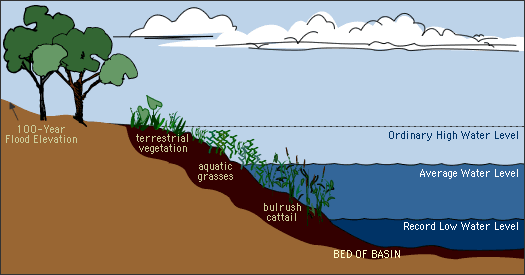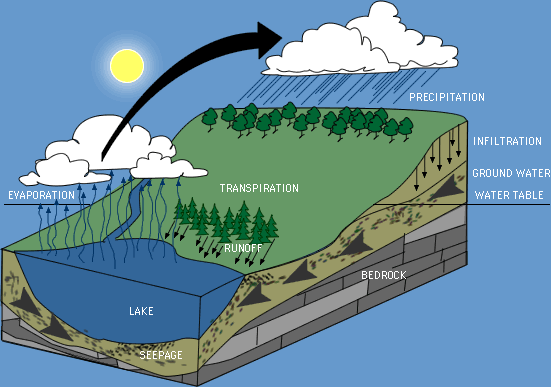 |
 |
LAKE LEVELS –
THE UPS AND DOWNS
OF MANAGING LAKES
![]()
- What is the Ordinary High Water Level?
- Why do the water levels in lakes change?
- What happens when water levels change?
- What is the right level for a lake?
- Who is responsible for managing lake levels in reservoirs?
- Who owns the lake and lakebed?
- Who can I contact if I have questions or a problem related to lake levels?
- What are some additional resources related to lake levels?
What is the Ordinary High Water Level?
The Ordinary High Water Level (OHW), is the highest level at which the water has remained long enough to leave evidence on the landscape. Generally, it is the point where the natural vegetation changes from predominantly aquatic to predominantly terrestrial plants. In streams, the OHW mark is generally the top of the bank of the channel.
Why do the water levels in lakes change?
Lake levels fluctuate naturally due to rain, snowmelt, drought, or changes in groundwater level. Any land use changes within a particular watershed may cause a change in the level of a lake within the watershed. Irrigation, drainage, sediment deposits, dams (built by beavers or humans), and other activities that change the flow of water into or out of the lake affect the lake level. Some lake levels are actively managed, often for power generation or flood control. Well-known examples of managed waters include reservoirs along the Mississippi and St. Louis rivers and lakes bordering Canada. Lakes that are managed to generate electricity can fluctuate significantly throughout a year, particularly during times of drought or flooding.
What happens when water levels change?
Fluctuations in water level often cause erosion and sedimentation, may damage property and upland vegetation, and can wash contaminants into lakes and rivers. Access to roads and to water for recreation may be affected. Wells and septic systems may develop problems when water levels change. A decrease in water level can stimulate plant growth near shore, potentially stabilizing sediments and increasing water clarity, but it can harm fisheries by reducing spawning areas and raising water temperature.
What is the right level for a lake?
Lakes, like people, change over time. Given geological time, there is no "right" level for a lake. Historically, the lake you are considering may have looked vastly different than it does now. It may not be possible to determine the historical level of your lake by looking at it, but you could try checking local historical sources for photographs and descriptions.
Who is responsible for managing lake levels in reservoirs?
It depends on the reservoir. Some reservoirs are managed by power companies. Lakes along the border between the U.S. and Canada are managed by the International Joint Commission. On inland reservoirs, the DNR maintains its own dams, but a county or local government usually controls the reservoir water levels. Some water behind a dam must be released at all times to maintain river flow below the dam. Low flow periods are critical for fish – when riffle areas dry out, invertebrate populations (food for small fish) decline, spawning areas decline, and the water temperature rises. The U.S. Army Corps of Engineers has jurisdiction over locks and dams on navigable waters.
Who owns the lake and lakebed?
We all “own” Minnesota’s lakes, but the state manages the waters. “Waters of the State” include all surface or underground waters, except surface waters which are not confined but are spread over the land (Minnesota Statutes, Section 103G.005, subd. 17). All lakes, ponds, marshes, rivers, streams, ditches, springs, and water from underground aquifers, regardless of size or location, are considered “Waters of the State.”
The State of Minnesota owns the bed of the lake if it is navigable according to a federal test based on whether the waters are used as highways for commerce or travel. Lakebeds are also considered state-owned if they could be used for commerce in their natural or ordinary condition, even if they are not currently in use. Owners of adjacent land own the bed of the lake or to the centerline of a stream if it is NOT navigable and meandered. If it is NOT navigable and NOT meandered, the owners of the streambed are indicated on individual property deeds.
Who can I contact if I have questions or a problem related to lake levels?
Check your local telephone listing, the “Who to Contact” section of the Minnesota Shoreland Management Resource Guide Web site, www.shorelandmanagement.org, or the Web sites listed below for:
- Your county Water Plan Coordinator
- Your county Soil and Water Conservation District office (SWCD) (www.maswcd.org)
- Natural Resources Conservation Service (NRCS) (www.mn.nrcs.usda.gov)
- Minnesota Department of Natural Resources (MDNR) (www.dnr.state.mn.us)
- U.S. Army Corps of Engineers (U.S. ACE) (www.mvp.usace.army.mil)
What are some additional resources related to lake levels?
- Work That Can Be Done Without a Protected Waters Permit. 1994. Minnesota Department of Natural Resources, Division of Waters
- A Guide for Buying & Managing Shoreland. 1988. Minnesota Department of Natural Resources, Division of Waters
- Streambank Erosion…Gaining a Greater Understanding. 1991. Minnesota Department of Natural Resources, Division of Waters

